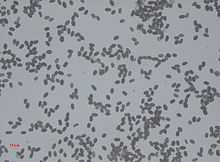Stachybotrys
| Stachybotrys | |
|---|---|
| Scientific classification | |
| Kingdom: | Fungi |
| Phylum: | Ascomycota |
| Class: | Sordariomycetes |
| Order: | Hypocreales |
| Genus: | Stachybotrys Corda, 1837 |
| Species | |
|
~ 50, see text | |
Stachybotrys is a genus of molds, or asexually reproducing, filamentous fungi. Closely related to the genus Memnoniella,[1][2] most Stachybotrys species inhabit materials rich in cellulose. The genus has a widespread distribution, and contains about 50 species.[3] The name comes the Greek words "stakhus" (ear of grain, stalk, stick; σταχυς) or "stachy" (progeny) and "botrus" (cluster or bunch as in grapes, trusses; βότρυς).
The most infamous species, S. chartarum (previously known as S. atra) and S. chlorohalonata are known as "black mold" or "toxic black mold" in the U.S. and are frequently associated with poor indoor air quality that arises after fungal growth on water-damaged building materials.[4]
Pathogenicity

Symptoms of Stachybotrys exposure in humans
Exposure to the mycotoxins present in Stachybotrys chartarum or Stachybotrys atra can have a wide range of effects. Depending on the length of exposure and volume of spores inhaled or ingested, symptoms can manifest as chronic fatigue or headaches, fever, irritation to various areas including the eyes, mucous membranes of the mouth, nose and throat, as well as other symptoms such as sneezing, rashes, and chronic coughing. In severe cases of exposure or cases exacerbated by allergic reaction, symptoms can be extreme including nausea, vomiting, and bleeding in the lungs and nose.[5] The controversy began in the early 1990s after analysis of two infantile deaths and multiple cases in children from the poor areas of Cleveland, Ohio due to pulmonary hemorrhage were initially linked to exposure to heavy amounts of Stachybotrys chartarum. Subsequent and extensive reanalysis of the cases by the United States Centers for Disease Control and Prevention have failed to find any link between the deaths and the mold exposure.[6]
Species
- Stachybotrys albipes (Berk. & Broome) S.C. Jong & Davis (1976)
- Stachybotrys alternans Bonord. (1851)
- Stachybotrys breviuscula McKenzie (1991)
- Stachybotrys chartarum (Ehrenb.) S. Hughes (1958)
- Stachybotrys chlorohalonata B. Andersen & Thrane (2003)
- Stachybotrys cylindrospora C.N. Jensen (1912)
- Stachybotrys dichroa Grove (1886)
- Stachybotrys elegans (Pidopl.) W. Gams (1980)
- Stachybotrys eucylindrospora D.W. Li (2007)
- Stachybotrys freycinetiae McKenzie (1991)
- Stachybotrys kampalensis Hansf. (1943)
- Stachybotrys kapiti Whitton, McKenzie & K.D. Hyde (2001)
- Stachybotrys longispora Matsush. (1975)
- Stachybotrys mangiferae P.C. Misra & S.K. Srivast. (1982)
- Stachybotrys microspora (B.L. Mathur & Sankhla) S.C. Jong & E.E. Davis (1976)
- Stachybotrys nephrodes McKenzie (1991)
- Stachybotrys nephrospora Hansf. (1943)
- Stachybotrys nilagirica Subram. (1957)
- Stachybotrys oenanthes M.B. Ellis (1971)
- Stachybotrys parvispora S. Hughes (1952)
- Stachybotrys ruwenzoriensis Matsush. (1985)
- Stachybotrys sansevieriae G.P. Agarwal & N.D. Sharma (1974)
- Stachybotrys sinuatophora Matsush. (1971)
- Stachybotrys suthepensis Photita, P. Lumyong, K.D. Hyde & McKenzie (2003)
- Stachybotrys theobromae Hansf. (1943)
- Stachybotrys waitakere Whitton, McKenzie & K.D. Hyde (2001)
See also
References
- ↑ Haugland, RA, Vesper SJ, Harmon SM (2001). "Phylogenetic relationships of Memnoniella and Stachybotrys species and evaluation of morphological features for Memnoniella species identification". Mycologia (Mycologia, Vol. 93, No. 1) 93 (1): 54–65. doi:10.2307/3761605. JSTOR 3761605.
- ↑ Castlebury L, Rossman A, Sung G, Hyten A, Spatafora J (2004). "Multigene phylogeny reveals new lineage for Stachybotrys chartarum, the indoor air fungus". Mycol Res 108 (Pt 8): 864–72. doi:10.1017/S0953756204000607. PMID 15449591.
- ↑ Kirk PM, Cannon PF, Minter DW, Stalpers JA. (2008). Dictionary of the Fungi (10th ed.). Wallingford: CABI. p. 659. ISBN 978-0-85199-826-8.
- ↑ Fog Nielsen K (2003). "Mycotoxin production by indoor molds". Fungal Genet Biol 39 (2): 103–17. doi:10.1016/S1087-1845(03)00026-4. PMID 12781669.
- ↑ Richard F. Progovitz. Black Mold: Your Health and Your Home. Note that the effect (strength) depends on the person and their immune system AND physiology.. p. 97.
- ↑ Centers for Disease Control and Prevention (CDC) (2001). "Availability of case definition for acute idiopathic pulmonary hemorrhage in infants.". MMWR 50: 494–495.
Further reading
- Black Mold: Your Health and Your Home (2003) ISBN 0-9743943-9-4
External links
- www.cdc.gov/mold/stachy.htm, "Facts about Stachybotrys chartarum and Other Molds", United States Center for Disease Control and Prevention